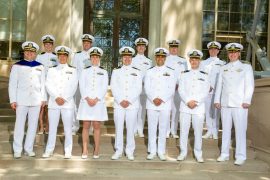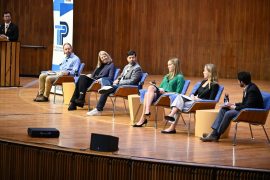A college for the computing age

With the initial organizational structure in place, the MIT Schwarzman College of Computing moves forward with implementation.
The mission of the MIT Stephen A. Schwarzman College of Computing is to address the opportunities and challenges of the computing age — from hardware to software to algorithms to artificial intelligence (AI) — by transforming the capabilities of academia in three key areas: supporting the rapid evolution and growth of computer science and AI; facilitating collaborations between computing and other disciplines; and focusing on social and ethical responsibilities of computing through combining technological approaches and insights from social science and humanities, and through engagement beyond academia.
Since starting his position in August 2019, Daniel Huttenlocher, the inaugural dean of the MIT Schwarzman College of Computing, has been working with many stakeholders in designing the initial organizational structure of the college. Beginning with the College of Computing Task Force Working Group reports and feedback from the MIT community, the structure has been developed through an iterative process of draft plans yielding a 26-page document outlining the initial academic organization of the college that is designed to facilitate the college mission through improved coordination and evolution of existing computing programs at MIT, improved collaboration in computing across disciplines, and development of new cross-cutting activities and programs, notably in the social and ethical responsibilities of computing.
“The MIT Schwarzman College of Computing is both bringing together existing MIT programs in computing and developing much-needed new cross-cutting educational and research programs,” says Huttenlocher. “For existing programs, the college helps facilitate coordination and manage the growth in areas such as computer science, artificial intelligence, data systems and society, and operations research, as well as helping strengthen interdisciplinary computing programs such as computational science and engineering. For new areas, the college is creating cross-cutting platforms for the study and practice of social and ethical responsibilities of computing, for multi-departmental computing education, and for incubating new interdisciplinary computing activities.”
The following existing departments, institutes, labs, and centers are now part of the college:
- Department of Electrical Engineering and Computer (EECS), which has been reorganized into three overlapping sub-units of electrical engineering (EE), computer science (CS), and artificial intelligence and decision-making (AI+D), and is jointly part of the MIT Schwarzman College of Computing and School of Engineering;
- Operations Research Center (ORC), which is jointly part of the MIT Schwarzman College of Computing and MIT Sloan School of Management;
- Institute for Data, Systems, and Society (IDSS), which will be increasing its focus on the societal aspects of its mission while also continuing to support statistics across MIT, and including the Technology and Policy Program (TPP) and Sociotechnical Systems Research Center (SSRC);
- Center for Computational Science Engineering (CCSE), which is being renamed from the Center for Computational Engineering and broadening its focus in the sciences;
- Computer Science and Artificial Intelligence Laboratory (CSAIL);
- Laboratory for Information and Decision Systems (LIDS); and
- Quest for Intelligence.
With the initial structure in place, Huttenlocher, the college leadership team, and the leaders of the academic units that are part of the college, in collaboration with departments in all five schools, are actively moving forward with curricular and programmatic development, including the launch of two new areas, the Common Ground for Computing Education and the Social and Ethical Responsibilities of Computing (SERC). Still in the early planning stages, these programs are the aspects of the college that are designed to cut across lines and involve a number of departments throughout MIT. Other programs are expected to be introduced as the college continues to take shape.
“The college is an Institute-wide entity, working with and across all five schools,” says Anantha Chandrakasan, dean of the School of Engineering and the Vannevar Bush Professor of Electrical Engineering and Computer Science, who was part of the task force steering committee. “Its continued growth and focus depend greatly on the input of our MIT community, a process which began over a year ago. I’m delighted that Dean Huttenlocher and the college leadership team have engaged the community for collaboration and discussion around the plans for the college.”
With these organizational changes, students, faculty, and staff in these units are members of the college, and in some cases, jointly with a school, as will be those who are engaged in the new cross-cutting activities in SERC and Common Ground. “A question we get frequently,” says Huttenlocher, “is how to apply to the college. As is the case throughout MIT, undergraduate admissions are handled centrally, and graduate admissions are handled by each individual department or graduate program.”
Advancing computing
Despite the unprecedented growth in computing, there remains substantial unmet demand for expertise. In academia, colleges and universities worldwide are faced with oversubscribed programs in computer science and the constant need to keep up with rapidly changing materials at both the graduate and undergraduate level.
According to Huttenlocher, the computing fields are evolving at a pace today that is beyond the capabilities of current academic structures to handle. “As academics, we pride ourselves on being generators of new knowledge, but academic institutions themselves don’t change that quickly. The rise of AI is probably the biggest recent example of that, along with the fact that about 40 percent of MIT undergraduates are majoring in computer science, where we have 7 percent of the MIT faculty.”
In order to help meet this demand, MIT is increasing its academic capacity in computing and AI with 50 new faculty positions — 25 will be core computing positions in CS, AI, and related areas, and 25 will be shared jointly with departments. Searches are now active to recruit core faculty in CS and AI+D, and for joint faculty with MIT Philosophy, the Department of Brain and Cognitive Sciences, and several interdisciplinary institutes.
The new shared faculty searches will largely be conducted around the concept of “clusters” to build capacity at MIT in important computing areas that cut across disciplines, departments, and schools. Huttenlocher, the provost, and the five school deans will work to identify themes based on input from departments so that recruiting can be undertaken during the next academic year.
Cross-cutting collaborations in computing
Building on the history of strong faculty participation in interdepartmental labs, centers, and initiatives, the MIT Schwarzman College of Computing provides several forms of membership in the college based on cross-cutting research, teaching, or external engagement activities. While computing is affecting intellectual inquiry in almost every discipline, Huttenlocher is quick to stress that “it’s bi-directional.” He notes that existing collaborations across various schools and departments, such as MIT Digital Humanities, as well as opportunities for new such collaborations, are key to the college mission because in the same way that “computing is changing thinking in the disciplines; the disciplines are changing the way people do computing.”
Under the leadership of Asu Ozdaglar, the deputy dean of academics and department head of EECS, the college is developing the Common Ground for Computing Education, an interdepartmental teaching collaborative that will facilitate the offering of computing classes and coordination of computing-related curricula across academic units.
The objectives of this collaborative are to provide opportunities for faculty across departments to work together, including co-teaching classes, creating new undergraduate majors or minors such as in AI+D, as well as facilitating undergraduate blended degrees such as 6-14 (Computer Science, Economics, and Data Science), 6-9 (Computation and Cognition), 11-6 (Urban Science and Planning with Computer Science), 18-C (Mathematics with Computer Science), and others.
“It is exciting to bring together different areas of computing with methodological and substantive commonalities as well as differences around one table,” says Ozdaglar. “MIT faculty want to collaborate in topics around computing, but they are increasingly overwhelmed with teaching assignments and other obligations. I think the college will enable the types of interactions that are needed to foster new ideas.”
Thinking about the impact on the student experience, Ozdaglar expects that the college will help students better navigate the computing landscape at MIT by creating clearer paths. She also notes that many students have passions beyond computer science, but realize the need to be adept in computing techniques and methodologies in order to pursue other interests, whether it be political science, economics, or urban science. “The idea for the college is to educate students who are fluent in computation, but at the same time, creatively apply computing with the methods and questions of the domain they are mostly interested in.”
For Deputy Dean of Research Daniela Rus, who is also the director of CSAIL and the Andrew and Erna Viterbi Professor in EECS, developing research programs “that bring together MIT faculty and students from different units to advance computing and to make the world better through computing” is a top priority. She points to the recent launch of the MIT Air Force AI Innovation Accelerator, a collaboration between the MIT Schwarzman College of Computing and the U.S. Air Force focused on AI, as an example of the types of research projects the college can facilitate.
“As humanity works to solve problems ranging from climate change to curing disease, removing inequality, ensuring sustainability, and eliminating poverty, computing opens the door to powerful new solutions,” says Rus. “And with the MIT Schwarzman College as our foundation, I believe MIT will be at the forefront of those solutions. Our scholars are laying theoretical foundations of computing and applying those foundations to big ideas in computing and across disciplines.”
Habits of mind and action
A critically important cross-cutting area is the Social and Ethical Responsibilities of Computing, which will facilitate the development of responsible “habits of mind and action” for those who create and deploy computing technologies, and the creation of technologies in the public interest.
“The launch of the MIT Schwarzman College of Computing offers an extraordinary new opportunity for the MIT community to respond to today’s most consequential questions in ways that serve the common good,” says Melissa Nobles, professor of political science, the Kenan Sahin Dean of the MIT School of Humanities, Arts, and Social Sciences, and co-chair of the Task Force Working Group on Social Implications and Responsibilities of Computing.
“As AI and other advanced technologies become ubiquitous in their influence and impact, touching nearly every aspect of life, we have increasingly seen the need to more consciously align powerful new technologies with core human values — integrating consideration of societal and ethical implications of new technologies into the earliest stages of their development. Asking, for example, of every new technology and tool: Who will benefit? What are the potential ecological and social costs? Will the new technology amplify or diminish human accomplishments in the realms of justice, democracy, and personal privacy?
“As we shape the college, we are envisioning an MIT culture in which all of us are equipped and encouraged to think about such implications. In that endeavor, MIT’s humanistic disciplines will serve as deep resources for research, insight, and discernment. We also see an opportunity for advanced technologies to help solve political, economic, and social issues that trouble today’s world by integrating technology with a humanistic analysis of complex civilizational issues — among them climate change, the future of work, and poverty, issues that will yield only to collaborative problem-solving. It is not too much to say that human survival may rest on our ability to solve these problems via collective intelligence, designing approaches that call on the whole range of human knowledge.”
Julie Shah, an associate professor in the Department of Aeronautics and Astronautics and head of the Interactive Robotics Group at CSAIL, who co-chaired the working group with Nobles and is now a member of the college leadership, adds that “traditional technologists aren’t trained to pause and envision the possible futures of how technology can and will be used. This means that we need to develop new ways of training our students and ourselves in forming new habits of mind and action so that we include these possible futures into our design.”
The associate deans of Social and Ethical Responsibilities of Computing, Shah and David Kaiser, the Germeshausen Professor of the History of Science and professor of physics, are designing a systemic framework for SERC that will not only effect change in computing education and research at MIT, but one that will also inform policy and practice in government and industry. Activities that are currently in development include multi-disciplinary curricula embedded in traditional computing and AI courses across all levels of instruction, the commission and curation of a series of case studies that will be modular and available to all via MIT’s open access channels, active learning projects, cross-disciplinary monthly convenings, public forums, and more.
“A lot of how we’ve been thinking about SERC components is building capacity with what we already have at the Institute as a very important first step. And that means how do we get people interacting in ways that can be a little bit different than what has been familiar, because I think there are a lot of shared goals among the MIT community, but the gears aren’t quite meshing yet. We want to further support collaborations that might cut across lines that otherwise might not have had much traffic between them,” notes Kaiser.
Just the beginning
While he’s excited by the progress made so far, Huttenlocher points out there will continue to be revisions made to the organizational structure of the college. “We are at the very beginning of the college, with a tremendous amount of excellence at MIT to build on, and with some clear needs and opportunities, but the landscape is changing rapidly and the college is very much a work in progress.”
The college has other initiatives in the planning stages, such as the Center for Advanced Studies of Computing that will host fellows from inside and outside of MIT on semester- or year-long project-oriented programs in focused topic areas that could seed new research, scholarly, educational, or policy work. In addition, Huttenlocher is planning to launch a search for an assistant or associate dean of equity and inclusion, once the Institute Community and Equity Officer is in place, to focus on improving and creating programs and activities that will help broaden participation in computing classes and degree programs, increase the diversity of top faculty candidates in computing fields, and ensure that faculty search and graduate admissions processes have diverse slates of candidates and interviews.
“The typical academic approach would be to wait until it’s clear what to do, but that would be a mistake. The way we’re going to learn is by trying and by being more flexible. That may be a more general attribute of the new era we’re living in, he says. “We don’t know what it’s going to look like years from now, but it’s going to be pretty different, and MIT is going to be shaping it.”


